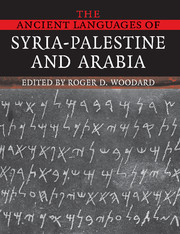Book contents
- Frontmatter
- Contents
- List of figures
- List of tables
- List of maps
- List of contributors
- Notes on numbering and cross-referencing
- List of abbreviations
- Preface
- Preface to the first edition
- Map
- 1 Language in ancient Syria-Palestine and Arabia: an introduction
- 2 Ugaritic
- 3 Hebrew
- 4 Phoenician and Punic
- 5 Canaanite dialects
- 6 Aramaic
- 7 Ancient South Arabian
- 8 Ancient North Arabian
- Appendix 1 Afro-Asiatic
- Appendix 2 Full tables of contents from The Cambridge Encyclopedia of the World's Ancient Languages, and from the other volumes in the paperback series
- Index of general subjects
- Index of grammar and linguistics
- Index of languages
- Index of named linguistic laws and principles
6 - Aramaic
Published online by Cambridge University Press: 22 September 2009
- Frontmatter
- Contents
- List of figures
- List of tables
- List of maps
- List of contributors
- Notes on numbering and cross-referencing
- List of abbreviations
- Preface
- Preface to the first edition
- Map
- 1 Language in ancient Syria-Palestine and Arabia: an introduction
- 2 Ugaritic
- 3 Hebrew
- 4 Phoenician and Punic
- 5 Canaanite dialects
- 6 Aramaic
- 7 Ancient South Arabian
- 8 Ancient North Arabian
- Appendix 1 Afro-Asiatic
- Appendix 2 Full tables of contents from The Cambridge Encyclopedia of the World's Ancient Languages, and from the other volumes in the paperback series
- Index of general subjects
- Index of grammar and linguistics
- Index of languages
- Index of named linguistic laws and principles
Summary
HISTORICAL AND CULTURAL CONTEXTS
Overview
Aramaic is a member of the Semitic language family and forms one of the two main branches of the Northwest Semitic group within that family, the other being Canaanite (comprising Hebrew, Phoenician, Moabite, etc.). The language most closely related to Aramaic is Hebrew. More distantly related languages include Akkadian and Arabic. Of all the Semitic languages, Aramaic is one of the most extensively attested, in both geographic and temporal terms. Aramaic has been continuously spoken for approximately 3,500 years (c. 1500 BC to the present) and is attested throughout the Near East and the Mediterranean world.
Aramaic was originally spoken by Aramean tribes who settled in portions of what is now Syria, Lebanon, Jordan, Turkey, and Iraq, a region bounded roughly by Damascus and its environs on the south, Mt. Amanus on the northwest and the region between the Balikh and the Khabur rivers on the northeast. The Arameans were a Semitic people, like their neighbors the Hebrews, the Phoenicians, and the Assyrians; and unlike the Hittites, Hurrians, and Urartians. Their economy was largely agricultural and pastoral, though villages and towns as well as larger urban centers, such as Aleppo and Damascus, also existed. These urban centers were usually independent political units, ruled by a king (Aramaic mlk), which exerted power over the surrounding agricultural and grazing regions and the nearby towns and villages.
- Type
- Chapter
- Information
- The Ancient Languages of Syria-Palestine and Arabia , pp. 108 - 144Publisher: Cambridge University PressPrint publication year: 2008
- 1
- Cited by



